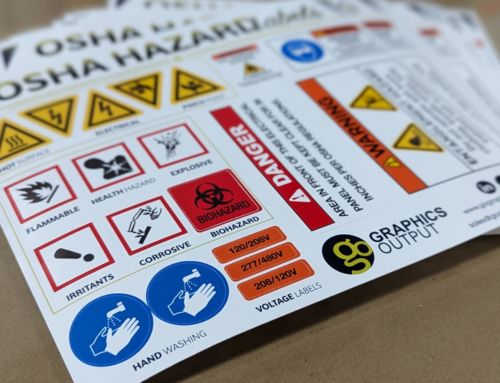Have you heard the terms solvent-based adhesive and water-based adhesive and gotten utterly confused? These terms are not as widely used in the graphics industry as other words used to define adhesives, such as “pressure-sensitive”, “high-tack”, “low-surface energy”, or “acrylic”, so naturally they cause a bit of confusion. Most graphic adhesives are made from acrylic, and acrylic adhesives can be either water-based or solvent-based. So what are the differences between these two?
Water-based Adhesive
Products with water-based adhesives, also referred to as emulsion, dispersion, solvent-free, or water adhesives, typically are a low-cost solution for either indoor or short-term outdoor graphic applications. This type of adhesive is found in a wide range of versatile projects like exterior labels, information decals, and interior signage and wall graphics. These use water to separate their adhesive molecules. When the water evaporates, strong bonds form.
”[Water-based adhesives are] environmentally friendly and are an economically viable alternative to solvent-based adhesives. One of the major advantages of waterborne adhesives is the absence of volatile organic compounds (VOCs)… Waterborne adhesives are usually considered very environmental friendly.”
Solvent-based Adhesive
According to Orafol, experts in the graphics material industry, solvent-based adhesive products are designed for more demanding and durable, longer-term applications. The components of this adhesive are combined with solvents, and when the solvents evaporate, what’s left is a structurally stronger, more durable adhesive that is more resistant to chemicals, cleaning agents, and wider temperature ranges.
An important attribute is the ability to use the “wet-application” method to apply graphics without worry of the adhesive losing bond to the substrate. This is because the water used in the wet-method with solvent adhesives will not prevent the solvents from evaporating correctly.
In summary, water-based adhesives form bonds when the water inside evaporates. They are better for short-term use and are more environmentally friendly. In contrast, solvent-based adhesives form bonds when the solvents inside evaporate, and they are more durable and chemical resistant.
If you are unsure of whether your adhesive is water or solvent based, feel free to reach out to your vendor or the OEM company. If you do not know the OEM for your adhesive, Graphics Output can help you find out the information you need to know, just email sales@gographicsoutput.com. As with any application, always perform a test of the adhesive for bond strength to ensure that it meets your expectations!

The use of adhesives was discovered in central Italy when stone flakes partially covered with birch bark tar and uncovered stone from the Middle Pleistocene era (circa 200,000 years ago) were found. This is thought to be the oldest discovery of human use of adhesives to make tar-hafted weapons and tools.




